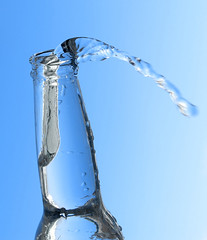HEALTHY FORESTS AND CLEAN water are interdependent. About 60 percent of freshwater resources in this country come from forests, which cover about one-third of the nation's land area. Forests absorb rain, refill underground aquifers, cool and cleanse water, slow storm run off, reduce flooding, regulate the melting of the snowpack at high altitudes, sustain watershed stability and resilience, provide critical habitat for fish and wildlife and supply water-based recreation and other benefits that improve our quality of life. Public concern about adequate supplies of clean water was a major reason for the establishment of a national forest system. American Forests was instrumental in that effort and continues to advocate for sound water policy today.
In celebration of the 40th anniversary of the Clean Water Act's creation. and to bring awareness to the continuing threats to our water resources, American Forests is proud to be a part of the Clean Water Network's Power of Water Campaign. The campaign aims to bring the nation's attention back to protecting our nation's waters so that our families and communities have clean and safe water to drink and the opportunity to swim, fish and safely enjoy our rivers, lakes and other bodies of water. As part of this effort, American Forests is highlighting the vital role forests play in ensuring we have clean water and the need for the protection and maintenance of forested watersheds.
The goal of the Clean Water Act (CWA) has been to restore and maintain the chemical, physical and biological integrity of our nation's waters. Since the act was passed in 1972, many of our water bodies and waterways are less polluted. Lake Erie, for example, which I was declared "dead" in the 1960s, now supports a multi-million-dollar fishery.
[ILLUSTRATION OMITTED]
The CWA separates water pollution into two types: point sources and non-point sources. A point source is any "discernible, confined and discrete conveyance from which pollutants are or may be discharged" such as pipes, ditches and wells. Non-point-source pollution is caused by rainfall or snowmelt moving over and through the ground, picking up natural and human-made pollutants and depositing them into lakes, rivers, wetlands, coastal waters and ground waters. In 1970, point-source pollution accounted for 85 percent of the pollutants in our waters and today accounts for only 15 percent. In addition to this success, the rate of wetland loss has declined by 90 percent since the 1970s. The Clean Water Act has accomplished a great deal over the past four decades, and we are indebted to the visionaries responsible for crafting' this landmark legislation.
But, we, as a nation, have not been as effective at addressing non-point-source pollution or the many new challenges that our rivers, streams and other bodies of water are now facing, such as invasive species. In the past 30 years, there has been a nearly threefold increase in nitrogen pollution from non-point sources entering the Gulf of Mexico from the Mississippi River and its tributaries. Commercial fertilizer used throughout the basin is the largest source of nitrogen, though other sources that contribute include animal waste, sewage treatment plants and nitrogen in the atmosphere from fossil fuel combustion. We need new tools to deal with non-point-source pollution and other emerging threats to water quality--pollutants in stormwater runoff, pharmaceuticals and personal care products, agricultural runoff and invasive species.
Forty years after the Clean Water Act, nearly half of all rivers, lakes and streams are still not swimmable and fishable, largely because of non-point source pollutants. While the 1972 CWA was innovative for its time, it needs an update to better meet the new and complex challenges of the 21st century. Healthy forests and forested watersheds, including riparian buffers, are an important part of any future strategies to address clean and plentiful water supplies. An updated Clean Water Act must recognize the role of forests in restoring and protecting watersheds and make them part of the solution to the water pollution challenges we face today.
Visit http://www.americanforests.org/forests-and-water/ to learn more about how important forests are to our water supply and what you can do to help keep them healthy.
60 percent of freshwater resources in this country come from forests, which cover about one-third of the nation's land area.
DID YOU KNOW?
The forested Catskill Mountains provide more than one billion gallons of freshwater to New York every day.
Source Citation
"American forests celebrates the 40th anniversary of the clean water act." American Forests Winter 2012: 14+. Agriculture Collection. Web. 22 Mar. 2012.
Document URL
http://go.galegroup.com/ps/i.do?id=GALE%7CA281469537&v=2.1&u=22054_acld&it=r&p=PPAG&sw=w
Gale Document Number: GALE|A281469537


No comments:
Post a Comment